Our Library
Explore our publications, from research papers and series to educational materials, covering all aspects of conflict transformation and peace promotion.
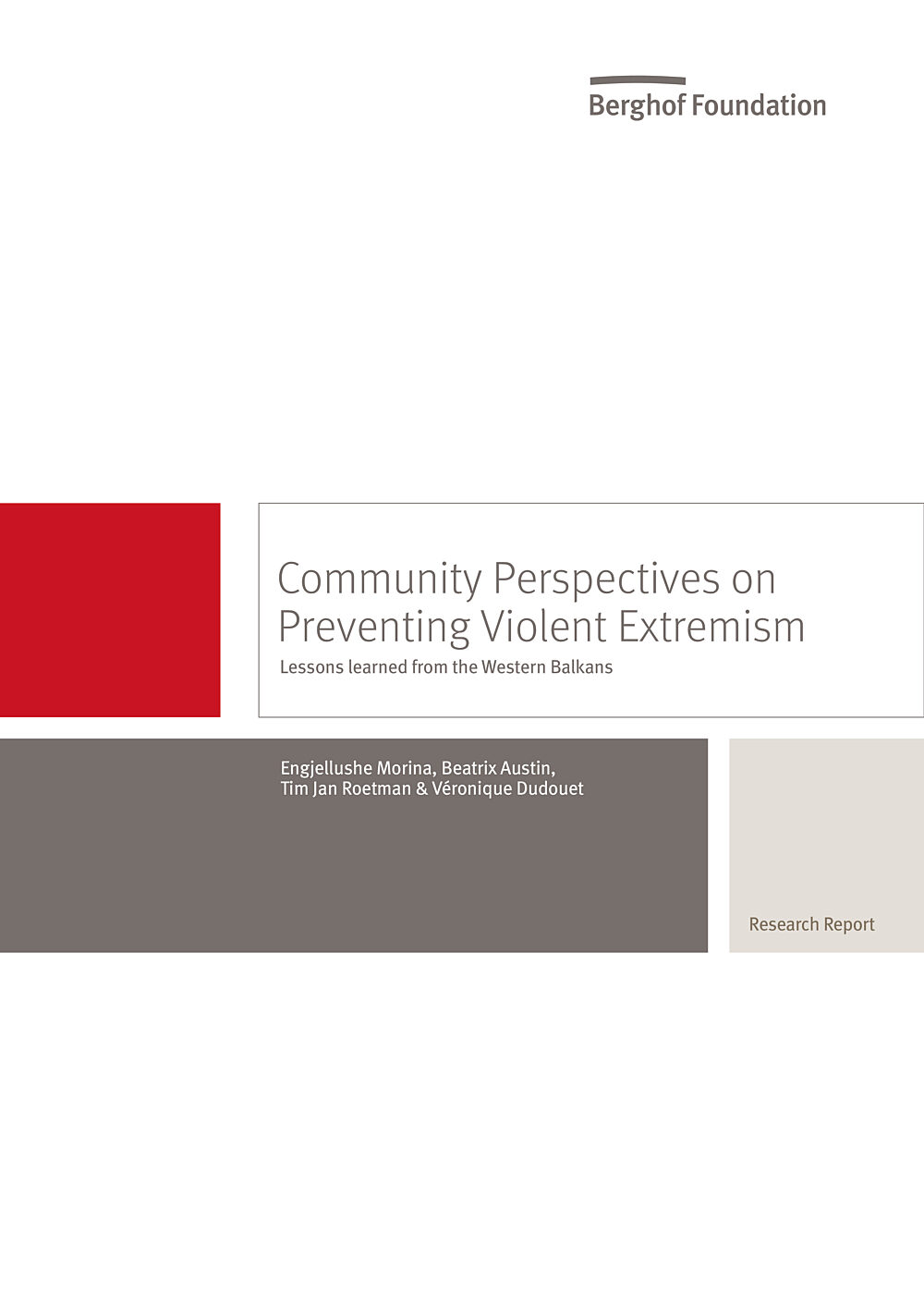
Community Perspectives on Preventing Violent ExtremismLessons learned from the Western Balkans
This comparative synthesis report – building on four country case studies covering Albania, Bosnia and Herzegovina, Kosovo and Macedonia – was produced in the framework of a participatory research project on “Opportunities for Preventing Violent Extremism in the Western Balkans”. Together with with four local research partners, we explore why some communities are particularly affected by individuals inspired by and/or joining the Islamic State (IS) or similar violent extremist groups, while other communities may show greater resilience to the same phenomenon. The project also includes policy outreach activities, both nationally and internationally, as well as local dialogue initiatives, in cooperation with local stakeholders and affected communities, in order to explore and develop strategies to prevent violent radicalisation in the Western Balkans in light of the research findings.
- Year2019
- Author(s)Engjellushe Morina, Beatrix Austin, Tim Jan Roetman, Véronique Dudouet

Perspektivat Komunitare për Parandalimin e Ekstremizmit të DhunshëmMësimet e nxjerra nga Ballkani Perëndimor
Ky raport krahasues, i bazuar në katër raste të ndryshme studimore në Shqipëri, Bosnjë dhe Hercegovinë, Kosovë dhe Maqedoni, u zhvillua në kuadër të projektit kërkimor “Mundësitë për Parandalimin e Ekstremizmit të Dhunshëm në Ballkanin Perëndimor”. Së bashku me katër partnerë hulumtues vendorë, në këtë raport shqyrtojmë pse disa komunitete janë veçanërisht të ndikuar nga individë që frymëzohen apo bëhen pjesë e Shtetit Islamik apo të grupeve të ngjashme të ekstremizmit të dhunshëm, ndërkohë që komunitete të tjera janë më të qëndrueshme ndaj të njëjtit fenomen. Në këtë projekt janë realizuar edhe diskutime me komunitetet, si në vend ashtu edhe në rang ndërkombëtar, si dhe nisma dialogu në nivel vendor në bashkëpunim me aktorët vendorë dhe komunitetet përkatëse për të shqyrtuar dhe hartuar strategji me qëllim parandalimin e radikalizimit të dhunshëm në Ballkanin Perëndimor nën dritën e gjetjeve të këtij hulumtimi.
- Year2019
- Author(s)Engjellushe Morina, Beatrix Austin, Tim Jan Roetman, Véronique Dudouet
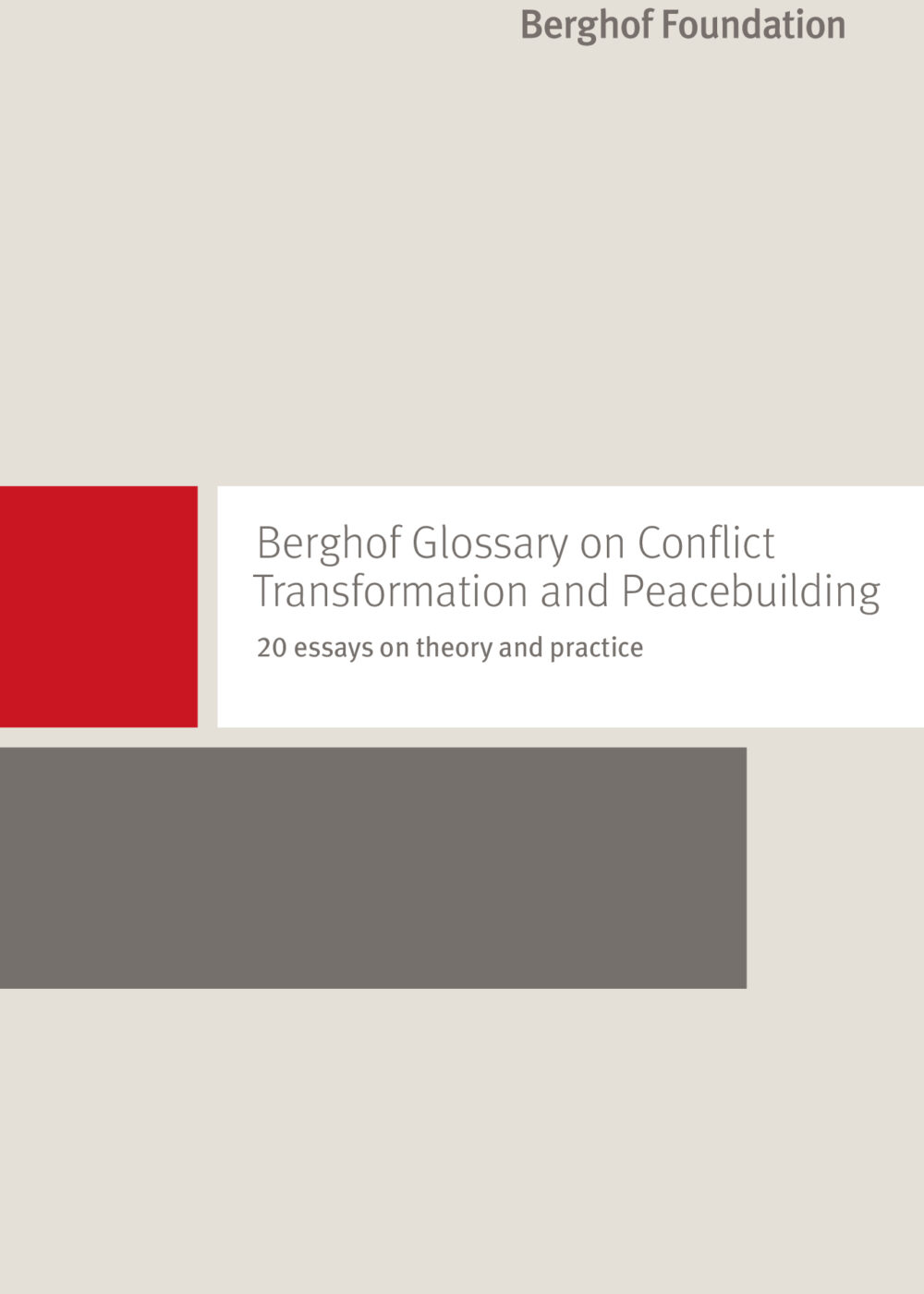
Berghof Glossary on Conflict Transformation20 Notions for Theory and Practice
The 2019 edition of the Berghof Glossary revisits the main principles and approaches that we use in our work to support people and conflict parties around the world. For a second time, our team has embarked on a joint exploration in order to chart a shared understanding of what it takes to create “space(s) for conflict transformation”.
- Year2019

Strategic thinking and conflict transformation: A reflection on and from the Basque CountryTransitions Series No. 14
The disarmament and dissolution of the Basque separatist group Euskadi Ta Askatasuna, better known under its acronym ETA, is a unique example of a creative and unilateral transition to end armed conflict. After the collapse of the negotiation process between the Spanish government and ETA in 2006, an internal debate within the Basque pro-independence movement led to a change of strategy. The new direction eventually resulted in the disarmament and dissolution of ETA in May 2018. How did it come about and what lessons can be drawn from this case for other conflicts? This report looks at these questions in detail, based on in-depth interviews with actors who took part in this democratic transition process as well as on the direct involvement and experiences of the author himself. Urko Aiartza previously coauthored another Transition Series report on the Basque peace process, covering the 1958-2007 period and the various attempts at negotiation between ETA and the Spanish Government (Aiartza and Zabalo 2009).
- Year2019
- Author(s)Urko Aiartza Azurtza
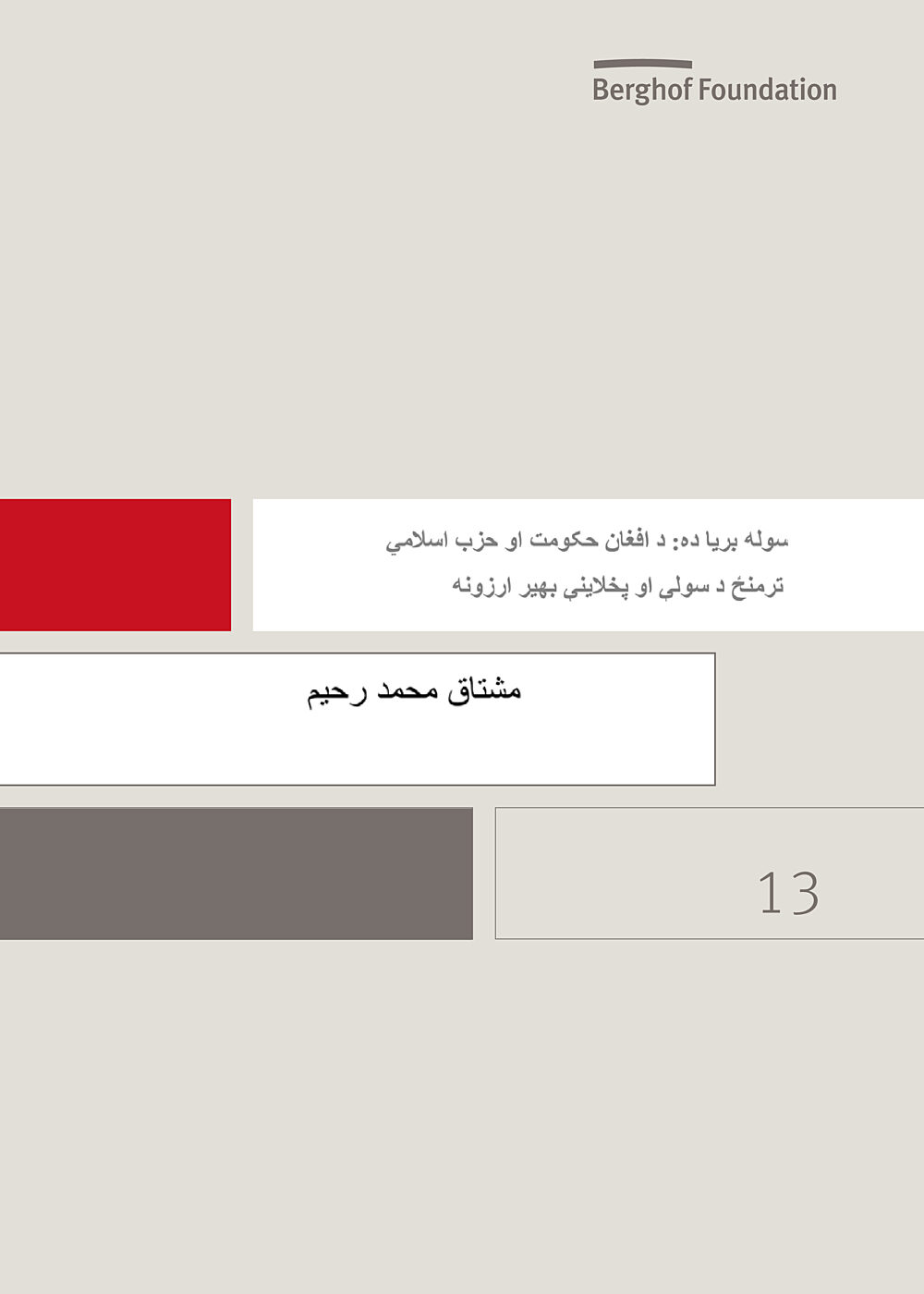
سوله بریا دهد افغان حکومت او حزب اسال مي تر منځ د سولې هوکړه لیک
په دې راپور کې د افغان حکومت او حزب اسالمي ترمنځ د سولې او پخالینې د هڅو شننه او څیړنه تررسه شوې ده. د سولې هوکړې ته د رسیدو لپاره یې اغیزمن الملونه او محدودیتونه مشخص کړي، هوکړې، د هوکړو پيل کول او السته راغلې تجربې یې چې په راتلونکې کې ورڅخه د سولې د مذاکراتو په برخه کې ګټه اخیستل کیدای يش، ارزويل او څیړيل دي. حزب اسالمي د یو ګوند په توګه په ۱۹۷۰ کال کې د اسالمي حکومت د رامنځته کولو په موخه جوړ شو. حزب اسالمي د یوې مهمې جهادي ډلې په توګه د افغانستان د شخړې په ټولو پړاوونو- لکه په ۱۹۸۰ کلونو کې د شوروي اتحاد د تیري کوونکو پوځونو او د هغوی له مالتړ څخه برخمن رژیم په وړاندې مبارزه، په ۱۹۹۰ کلونو کې د کورنیو جګړو، د طالبانو رسه د سیمو د کنټرول پهبرخه کې مستقیمه جګړه او په ۲۰۰۱ کال کې د طالبانو د رژیم له راپرځیدو وروسته د افغان حکومت او نړیوالو پوځونو مالتړیو په وړاندې جګړه کې- ونډه درلودلې ده.
- Year2019
- Author(s)Mushtaq Muhammad Rahim
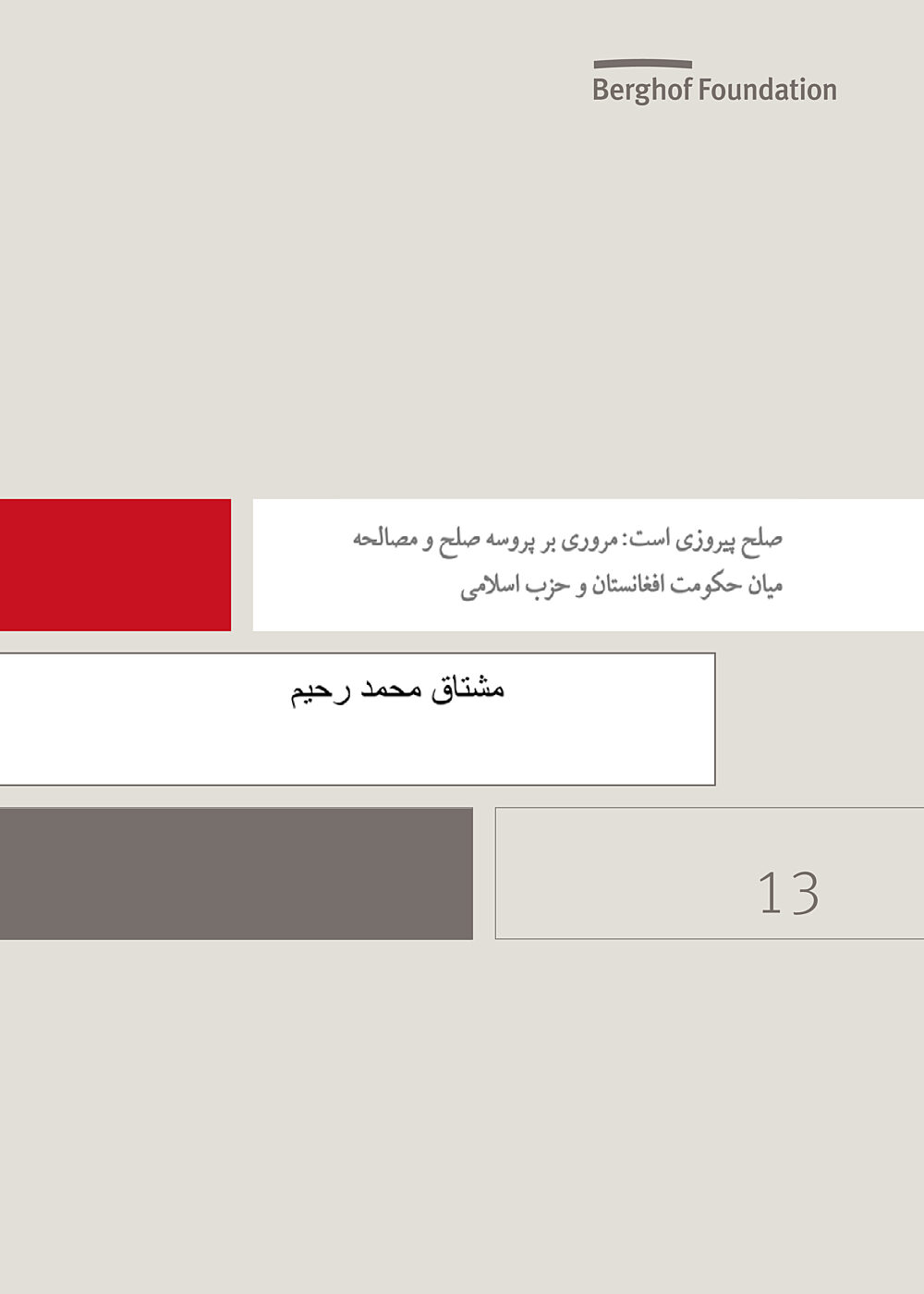
صلح پیروزی استمروری بر پروسه صلح و مصالحه میان حکومت افغانستان و حزب اسلامی
این گزارش تلاشهای صلح و مصالحه دولت افغانستان با حزب اسلامی را مورد تحلیل و بررسی قرار میدهد. عوامل میسر کننده و محدودیت ها را شناسایی نموده، توافقات بدست آمده و تطبیق آنها و همچنان تجارب بدست آمده را که میتواند در مذاکرات صلح در آینده از آن استفاده بعمل آید، مورد تحلیل قرار داده است. حزب اسلامی منحیث یک حزب در سالهای دهه ۱۹۷۰ به هدف ایجاد حکومت اسلامی تأسیس گردیده است. حزب اسلامی منحیث یک گروه اصلی جهادی در مراحل مختلفه منازعه- چون مبارزه با نیروهای متجاوز اتحاد جماهیر شوروی و رژیم تحت الحمایه آن در سالهای ۱۹۸۰ ،جنگ های داخلی در سالهای ۱۹۹۰ ،جنگ با طالبان جهت کنترول مناطق و بعد از سال ۲۰۰۱ و سقوط رژیم طالبان در جنگ با حکومت افغانستان و نیروهای بین المللی حمایت کننده آن- نقش داشته است.
- Year2019
- Author(s)Mushtaq Muhammad Rahim
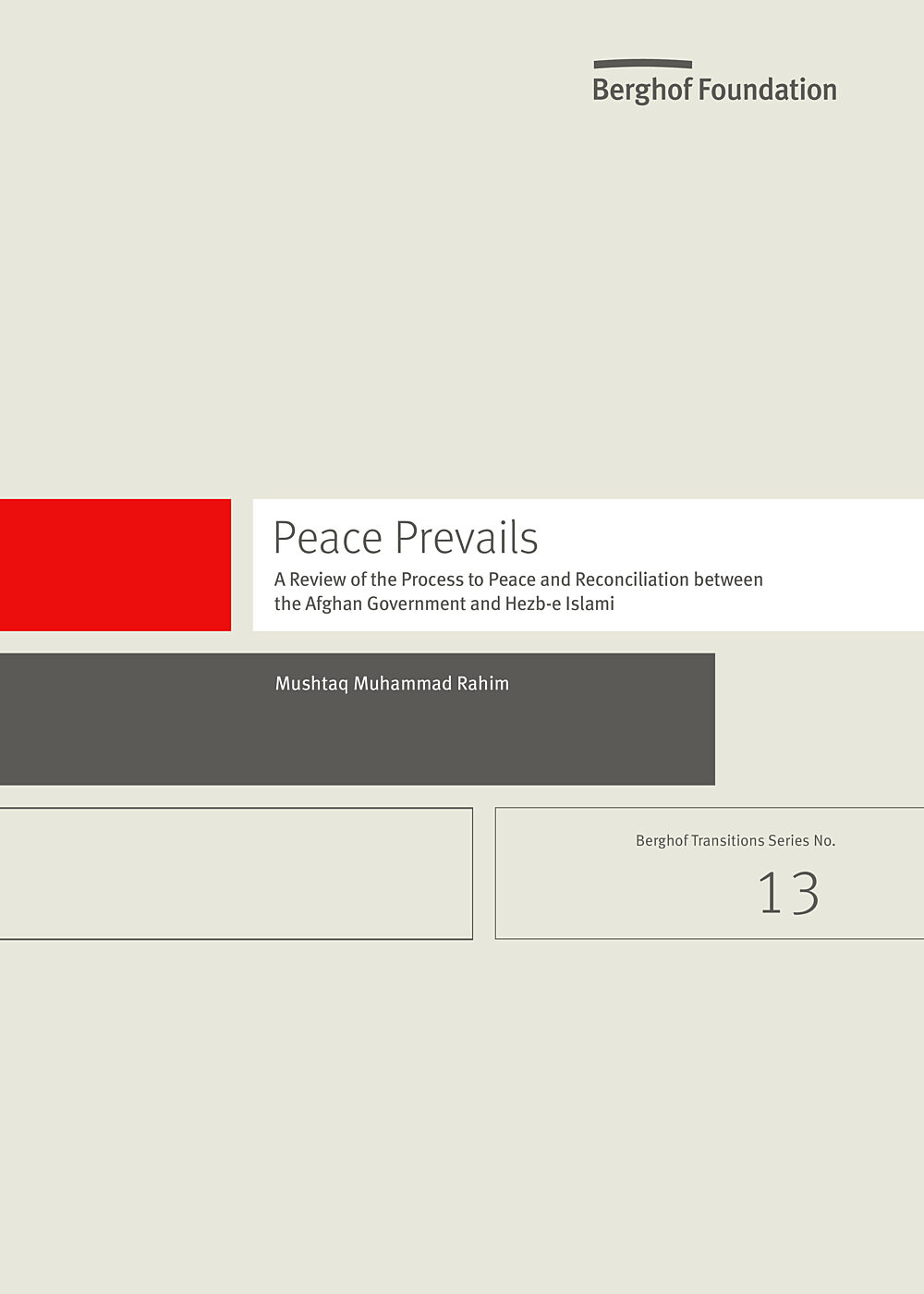
Peace Prevails: A Review of the Process to Peace and Reconciliation between the Afghan Government and Hezb-e IslamiTransitions Series No. 13
This study analyses the peace and reconciliation efforts of the Afghan government and the armed opposition group, Hezb-e Islami. It identifies enabling factors and limitations of the peace process, the resulting agreement and its implementation, as well as lessons learnt that can be used in future peace negotiations in Afghanistan. Hezb-e Islami was founded to establish Islamic governance in Afghanistan during the 1970s. It has been one of the main resistance groups throughout the various phases of armed conflict – fighting invading Soviet forces and the Soviet-backed regime throughout the 1980s and the civil war in the 1990s, battling the Taliban for territorial control and then, after the Taliban was ousted in 2001, combatting the Afghan government and its international backers.
- Year2019
- Author(s)Mushtaq Muhammad Rahim
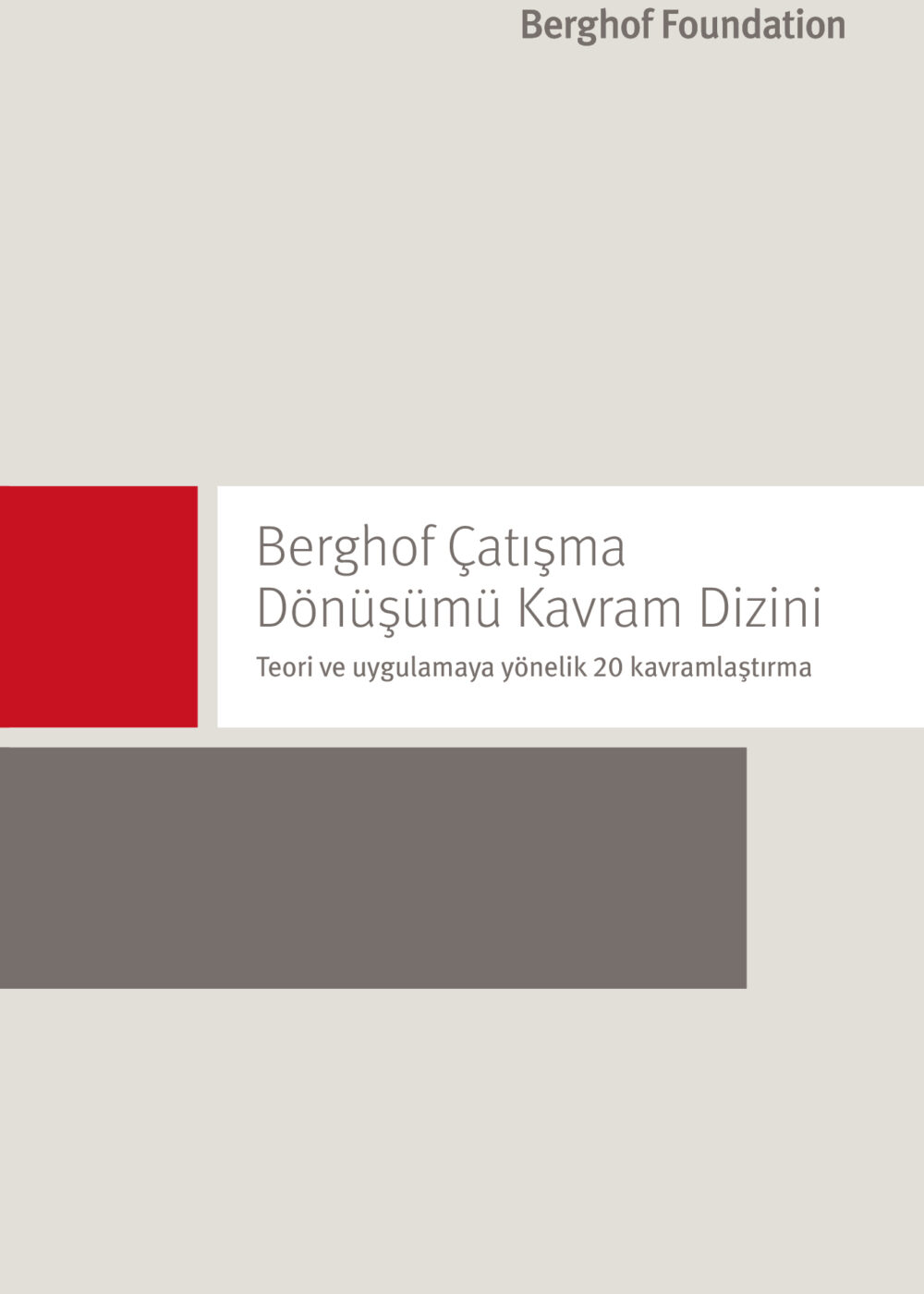
Berghof Çatışma Dönüşümü Kavram DiziniTeori ve uygulamaya yönelik 20 kavramlaştırma
Bu kavram dizini, Berghof Vakfı’nın çalışmalarında kullanılan çatışma dönüşümüne ilişkin 20 temel terimi tanımlamakta ve tartışmaktadır. Peki neden yeni bir kavram dizini ve özellikle de çatışmanın dönüştürülmesi alanında bir kavram dizini?
Öncelikle, “çatışma dönüşümü” kavramı, çatışma ve barış inşasına dair küresel söylemin hala nispeten yeni ve ayrı ve bir ayağıdır. Çatışma dönüşümü, çatışmaların varlığını toplumsal değişim ve gelişmenin kıymetli ve hatta vazgeçilmez bir parçası olarak görür, fakat şiddeti çatışan taraflar arasındaki ilişki ve etkileşimlerin kaçınılmaz bir parçası olarak algılamaz. Bu yüzden çatışmaların “çözümünü” uğraşının en önemli ve nihai amacı olarak görmez. Daha ziyade, çatışan özneler arasında yapıcı ilişiler kurmayı ve kalıcı barış için gereken mekanizmaların oluşturulmasına yardımcı olmayı amaçlar. Bunu, sürdürülebilir şiddet-içermeyen stratejileri üstün kılabilecek şekilde, çatışmaların temel nedenlerine nüfuz ederek yapar.
- Year2018
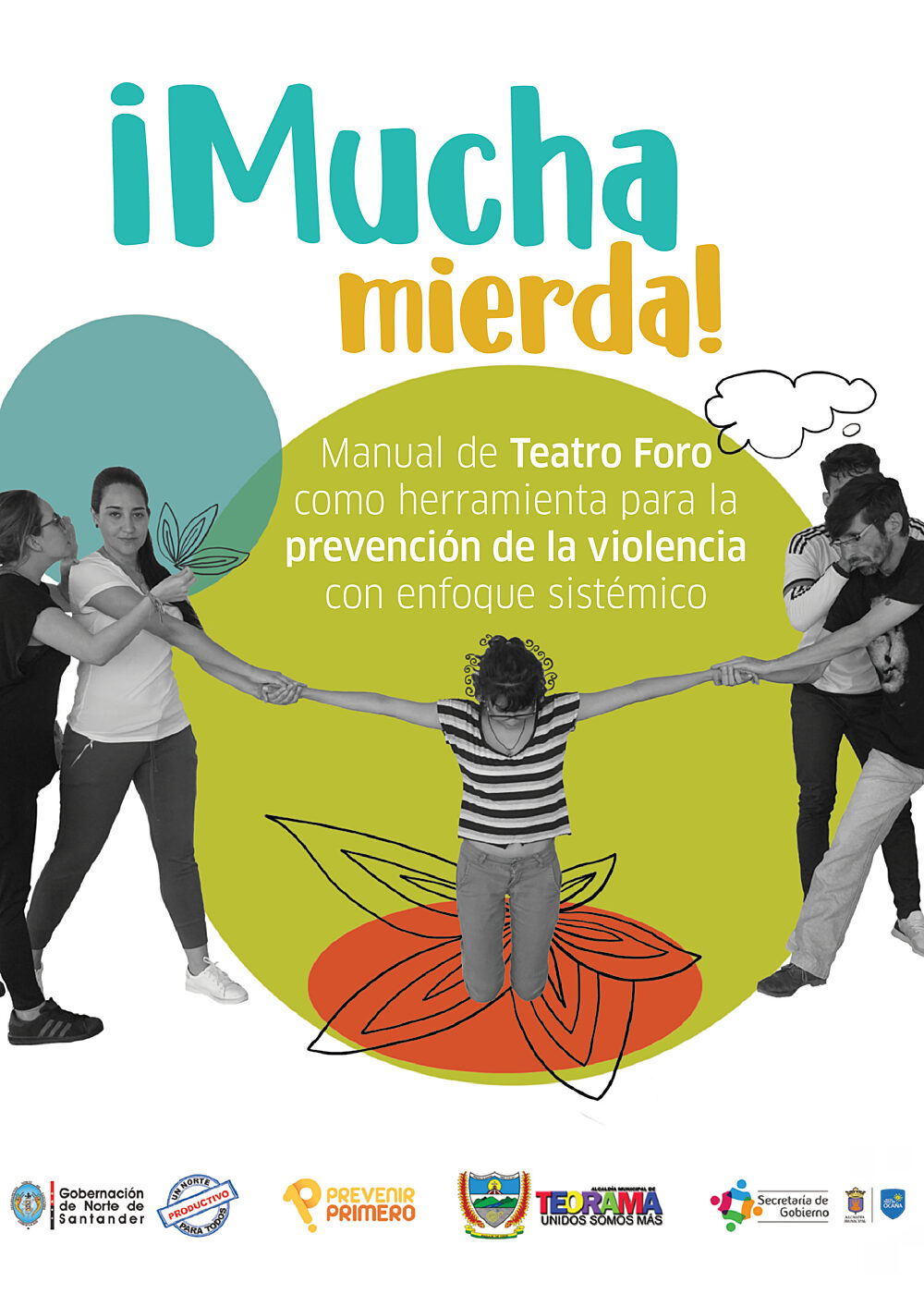
¡Mucha mierda!Manual de Teatro Foro como herramienta para la prevención de la violencia con enfoque sistémico
Este Manual sirve como ‘vademécum’ para las personas y organizaciones que hicieron parte del proceso piloto de ‘formación de formadores’ en Teatro Foro (TF) como herramienta para la prevención de la violencia con enfoque sistémico, en Norte de Santander. Compendia las metodologías y facilita su aplicación ordenada.
Es útil para cualquier persona interesada en TF, al dar un acercamiento comprensivo a los principales conceptos y técnicas de esta variación del teatro convencional, que consiste en invitar a entrar en escena a integrantes del público en un punto en el que la historia plantea un conflicto, para que actúen su propia manera de tramitarlo y así cada quien pase de ser espectador o espectadora pasivo/a, a convertirse en ‘espectactor’ o ‘espectactriz’ activo/a; que hace un aporte transformador y propicia el foro y el debate constructivo.
- Year2018
- Author(s)José Miguel Abad, Luis M. Benítez Páez
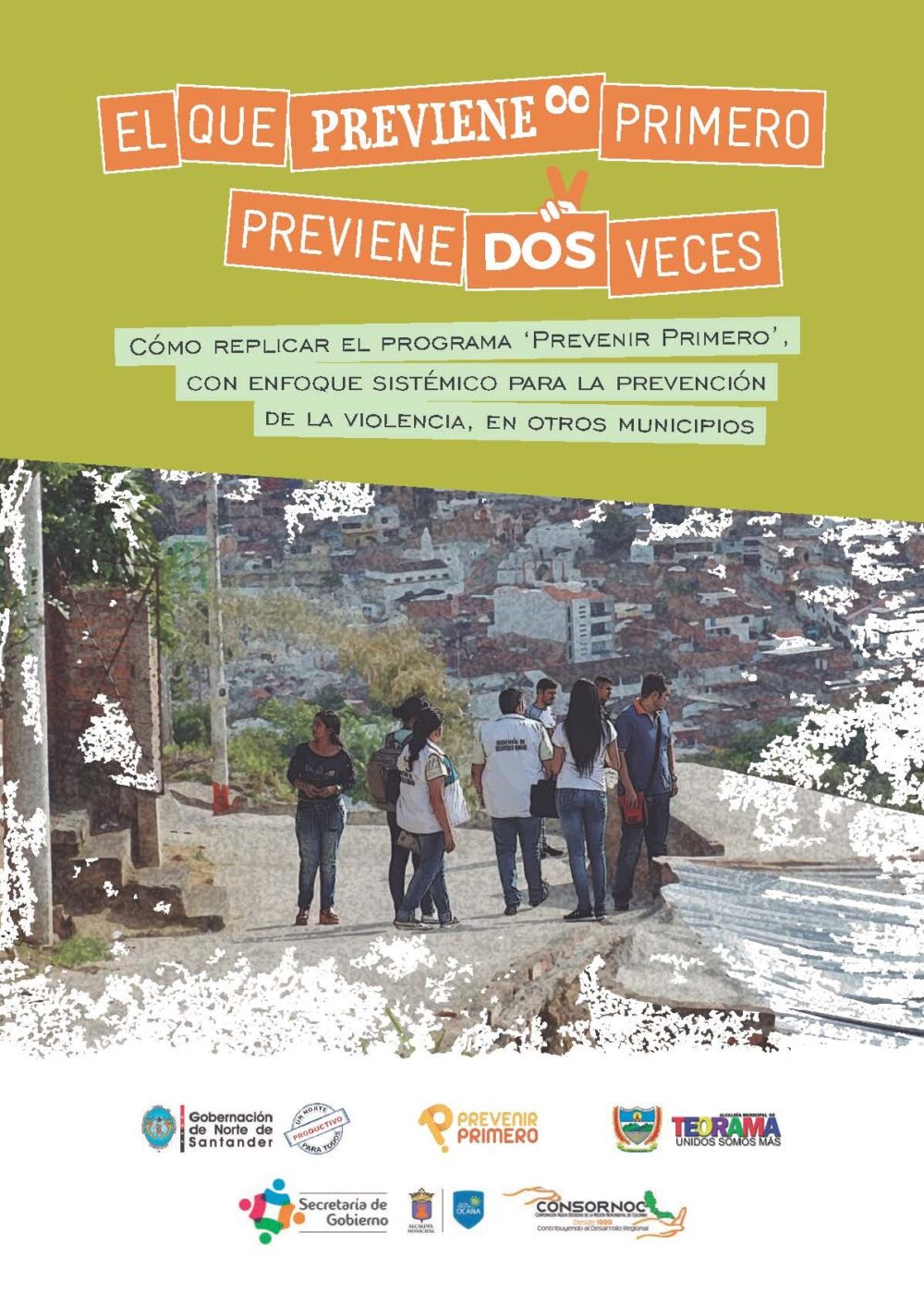
El que previene primero, previene dos vecesCómo replicar el programa ‘Prevenir Primero’, con enfoque sistémico para la prevención de la violencia, en otros municipios
El piloto introdujo conceptos, metodologías y herramientas del Enfoque Sistémico de Prevención de la Violencia, ESPV2, desarrollado por la GIZ3, y mostró la eficiencia de la cooperación multisectorial y multinivel en la prevención de la violencia, al desarrollar capacidades en personas e instituciones para gestionar intervenciones integrales y conseguir mejorar la percepción de seguridad en el caso particular de los barrios de Ocaña y Teorama en donde se trabajó. Los resultados positivos del piloto del programa ‘Prevenir Primero’ lo posicionan para su transferencia a nivel departamental.
- Year2018
- Author(s)Jorge Rodríguez Villasuso